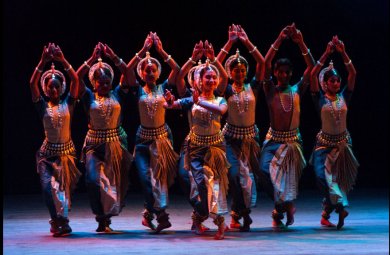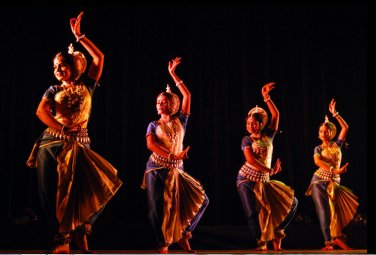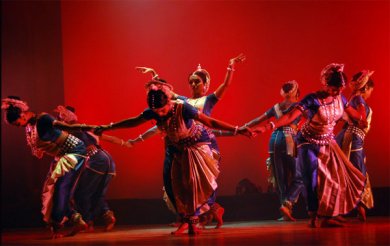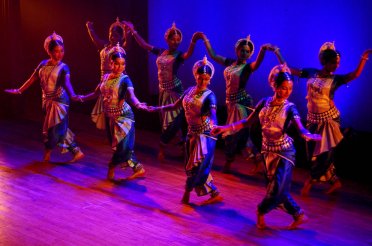
|   |

|   |
Antardrishti-Geetamritam, a neo-classical innovation in Odissi dance - Nita Vidyarthi e-mail: nitavidyarthi@gmail.com Photos courtesy: Srjan August 11, 2014 Personal knowledge and training in dance and mardal from the great Odissi Guru Kelucharan Mohapatra has imparted love of animated beauty and delight in choreographic skills to Ratikant Mohapatra, the guru’s illustrious son and disciple and director of Srjan, Guru Kelucharan Mohapatra Nrityabasa. His unquestioned authority on classical Odissi and sharp choreographic technique has ensured Srjan’s worthy productions of the neoclassical innovation in Odissi dance of recognition and superb quality. One such dance ballet is his latest piece ‘Geetamritam’ on Bhagavad Gita, staged for the first time in Kolkata at the Rabindranath Tagore Centre, in collaboration with ICCR, Kolkata on July 29th as the second part of the program entitled Antardrishti. 

Antardrishti began with ‘Ardhanarishwar’ as a tribute offered to Guru Kelucharan Mohapatra by the dancers of Srjan. Originally composed as a solo by the maestro, Ardhanarishwar has been imaginatively re-choreographed by Ratikant as a marvellous group number with fine linear and localized circular patterns suitable to the limited performing space. The piece draws the iconography of the image from the composition of Shankaracharya and portrays the coming together of the male and female principles Shiva and Parvati. After the invocation to Lord Jagannath, the thunderous beats of the mardal by Ratikant ushered in the 8 dancers to follow the Ardhanarishwara Ashtakam, Chaampeye gowrardha shareeri kayai set to Pt Raghunath Panigrahi’s music in Ragamalika, talamalika. With the advancement of singing of the stotra, the attributes of Shiva and Shakti are created with fascinating taal, chhanda and hasta mudras and movements using all the elements of classical Odissi invoking the inseparable female principle of Shakti from the male principle of Shiva. With the Shiva-Shakti imagery at the centre by two dancers, the others on either sides paint the remaining attributes mentioned in the stotra through dance. The most striking imagery was the use of the hand with the sarpashira mudra (hooded snake) around the neck of the dancer (Shiva) by another right behind her. ‘Geetamritam’ presented the essence of Gita through the Krishnarjuna context at the battlefield when Arjuna refuses to fight his kinsmen. Krishna advises him to go ahead as He is the creator of the universe and this ‘Dharma Yudh’ has to be fought because He desires so. Arjuna is only his medium. The momentous situation of Arjuna in the war field is symbolic of man’s own tryst with life and destiny. The dance ballet opens with an invocation and hymn to Vyasadeva. Dancers line up on two sides, the Pandavas and Kauravas, facing each other at the back of the stage while Krishna tries to convince the grief stricken and bewildered Arjuna to fight 

That Krishna is the Lord of the Universe and everything moves at his wish was enacted through consorted dance movements by a group of dancers weaving fine symmetrical patterns to portray the Dasavatar, the Vishwaroopa darshana, and a striking lifting of Giri-Govardhana, while Krishna and Arjuna remained at the forefront. A succession of lovely choreographic endeavour indeed! Rajashri Praharaj, a strong, senior dancer was convincing as Krishna. She was able to impart the variations of her smiles according to the demand of the situation with dignified grace to add interpretative proportions to her character. Manosmita Panda, also a fine dancer, concentrated more on her dancing but expressed her helplessness with ease. After the Geetopadesham, war is declared when Krishna blows the Panchjanya conch. This is a lovely scene to relish, while the dancers remain in still points. The choreography that dominated the whole production was the spectacular entry of Arjuna in the horse drawn chariot, Krishna being the charioteer. The uniform movements of the dancers as horses and as wheels rolling into the stage, was an unforgettable imagery of aesthetics and competence. It requires a high calibre as a teacher and great imagination to choreograph such a well designed phrasing of steps and get them executed with clockwork precision. Guru Ratikant must be lauded for this striking composition. Light by Debiprasad Mishra played a major role in enhancing the appeal especially at the entry of the chariot and the bloodshed war field. Another dazzling formation was the rise and fall of the dancers with quivering hands while sitting in a circle depicting “Prajwalita Gyanamoya Pradipa.” With the war declared, the production ends. A recital of Gita Mahaatmayam is added at the end to offer a sense of completeness to the performance. The dancers Preetisha Mohapatra, Arpita Swain, Aishwariya Singhdev, Sipra Swain, Pragna Paramita Das and Riyanka Chakravarty have solid training and with a strong sense of teamwork and harmony made the captivating production worthwhile. The costumes of peacock blue (colour for Krishna) and white depicting peace or wisdom are simple yet attractive. Ratikant’s choreography has incorporated some contemporary and classical ballet movements blended seamlessly with the classical Odissi. The music is by Pt Bhubaneswar Mishra, Pt Raghunath Panigrahi and Satyabrata Katha who also lends his voice. Rupak Kumar Paridha has also lent his voice for the last song. The script is by Pt Nityananda Mishra. Renowned academician and scholar professor Dr. Bharati Roy was highly impressed by the presentation and mentioned that she had never heard Gita being sung. The thunderous applause and standing ovation was very well deserved. Dr. Nita Vidyarthi is a critic of performing arts, specialising in dance, dance theatre and expressions and is a regular contributor to The Hindu, and the Statesman Kolkata in dance, vocal music and theatre. She is trained in Kathak, Bharatanatyam and Manipuri as well as vocal, semi-classical music and Rabindra Sangeet. A Science communicator, Ph.D. in Polymer Science, Commonwealth Scholar and a retired Professor of Chemistry, Nita devotes most of her time to dance and theatre writing. |